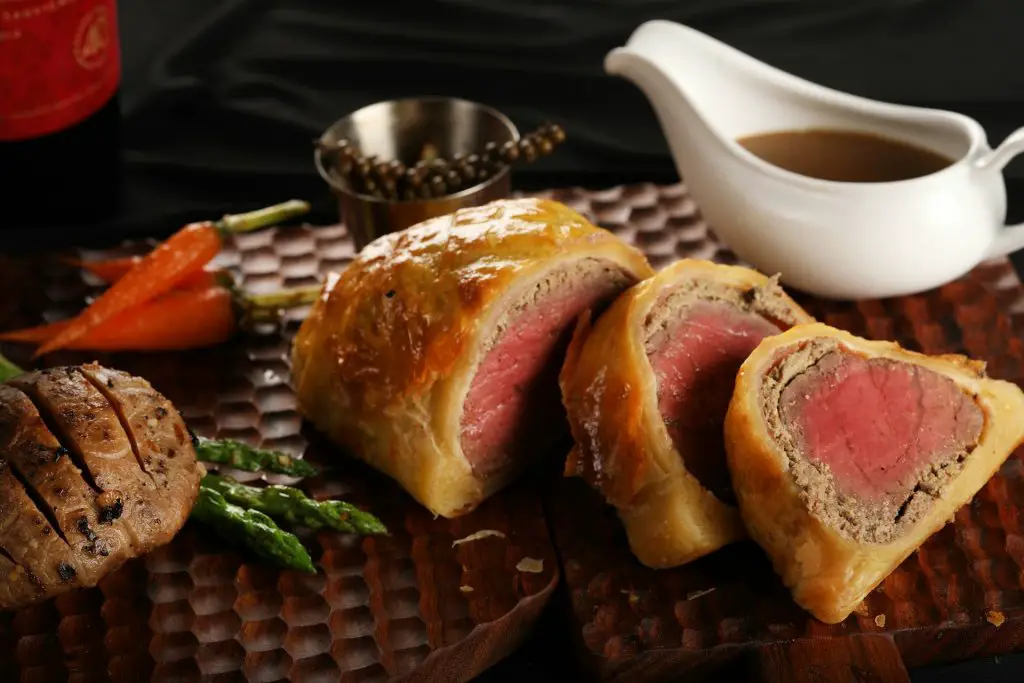Beef Wellington, with its succulent beef tenderloin encased in a crispy pastry shell, is a classic and elegant dish that never fails to impress. However, one common challenge many home cooks face when preparing this delectable masterpiece is preventing the bottom crust from turning soggy. The contrast between the crispy exterior and the juicy beef inside is what makes Beef Wellington exceptional, and maintaining that balance is key. In this article, we’ll explore the science behind the sogginess, and provide you with expert tips and techniques to ensure your Beef Wellington is perfectly crispy every time.
Understanding the Sogginess
The sogginess that plagues the bottom crust of Beef Wellington is primarily caused by excess moisture. This moisture can come from several sources:
The Meat: Beef Wellington typically features a tenderloin of beef, which is a relatively lean cut. However, even lean meats release some moisture during cooking. If this moisture is not properly managed, it can seep into the pastry crust.
The Mushroom Duxelles: A classic component of Beef Wellington, the mushroom duxelles is a mixture of finely chopped mushrooms, shallots, and herbs sautéed in butter. While delicious, this mixture also contains moisture that can contribute to a soggy crust if not prepared correctly.
The Pastry: Puff pastry, used to encase the beef and mushroom duxelles, is delicate and prone to absorbing moisture. If it becomes too wet, it loses its crispness.
Preventing Sogginess: Expert Tips
Now that we’ve identified the sources of moisture, let’s delve into strategies for preventing that dreaded soggy bottom crust:
Sear the Beef: Before wrapping the beef in puff pastry, it’s essential to sear it. A hot sear in a skillet or pan not only locks in the juices but also creates a flavorful crust that acts as a barrier against moisture.
Chilling: After searing the beef, allow it to cool completely in the refrigerator. This step is crucial as it helps reduce the meat’s moisture content and prevents it from releasing excess liquid while baking.
Drain the Mushroom Duxelles: When preparing the mushroom duxelles, take the time to thoroughly cook and reduce any moisture in the mixture. Drain excess liquid, if necessary, to avoid adding unwanted moisture to the pastry.
Use Prosciutto: A layer of prosciutto or ham can be added between the mushroom duxelles and the beef. Not only does this add an extra layer of flavor, but it also helps absorb and prevent excess moisture from reaching the pastry.
Brush with Egg Wash: Before wrapping the beef in puff pastry, brush the pastry with an egg wash. This creates a seal that helps keep moisture out and promotes browning for a beautifully golden crust.
Use a Parchment Lining: Placing a sheet of parchment paper on the baking sheet before placing the Beef Wellington on it can prevent direct contact between the pastry and any juices that may escape during cooking.
Elevate the Wellington: Using a wire rack on the baking sheet can elevate the Beef Wellington slightly, allowing any moisture to drip away from the pastry as it bakes.
Bake at High Heat: A high oven temperature, around 400°F (200°C) or higher, ensures that the pastry cooks quickly, creating a crispy shell before any moisture can penetrate it.
Rest Before Slicing: Once your Beef Wellington is out of the oven, let it rest for a few minutes before slicing. This allows the juices to redistribute within the meat, reducing the risk of moisture escaping onto the pastry.
Serve Immediately: Beef Wellington is at its best when served hot and fresh. Soggy crust is less likely to develop if you serve it promptly after baking.
Mastering the art of preventing a soggy bottom crust in your Beef Wellington takes practice, but with these expert tips and techniques, you’re well on your way to creating the perfect dish. Remember that controlling moisture is the key, from searing the beef to properly preparing the mushroom duxelles and handling the pastry. With patience and attention to detail, you can enjoy Beef Wellington with a beautifully crisp bottom crust every time, making your culinary endeavors truly impressive and delicious.
Troubleshooting Soggy Bottom Crust
While the tips mentioned above are designed to prevent a soggy bottom crust in your Beef Wellington, sometimes unexpected issues can arise. Here are some troubleshooting tips in case you encounter any problems:
Blind Bake the Pastry: If you are still concerned about moisture despite taking all precautions, you can consider blind baking the puff pastry. This involves partially baking the pastry shell before adding the meat and mushroom duxelles. This extra layer of protection can further ensure a crispy bottom crust.
Thicker Pastry Layer: If you notice that your pastry is still too thin and prone to sogginess, consider using a slightly thicker layer of puff pastry. This can provide an additional barrier against moisture.
Use a Meat Thermometer: To avoid overcooking the beef while waiting for the pastry to become golden brown, use a meat thermometer. This way, you can ensure the meat is cooked to your desired level of doneness without compromising the pastry.
Reduce Mushroom Duxelles Moisture: If you find that your mushroom duxelles is releasing excess moisture, consider adding breadcrumbs or ground nuts to absorb some of the liquid. These ingredients can help maintain the desired consistency.
Properly Seal the Edges: Ensure that you seal the edges of the pastry tightly to prevent any moisture from seeping in during baking. Use a fork or your fingers to crimp and seal the edges securely.
Adjust Cooking Time: Keep a close eye on your Beef Wellington during baking. If you notice the pastry browning too quickly or unevenly, you can cover the top with aluminum foil to protect it while allowing the beef to continue cooking.
Experiment: Cooking is an art, and Beef Wellington can vary depending on individual preferences and ingredients used. Don’t be afraid to experiment with different cuts of meat, herbs, or additional flavorings to find the perfect balance for your taste.
Beef Wellington is a timeless dish that deserves to be mastered, and achieving a perfectly crispy bottom crust is a significant part of that mastery. By understanding the sources of moisture, implementing expert tips to prevent sogginess, and being prepared to troubleshoot if needed, you can create Beef Wellington that not only delights your taste buds but also impresses your guests with its impeccable presentation. Whether you’re cooking for a special occasion or simply indulging your culinary passion, these techniques will help you elevate your Beef Wellington to new heights of deliciousness. Happy cooking!




